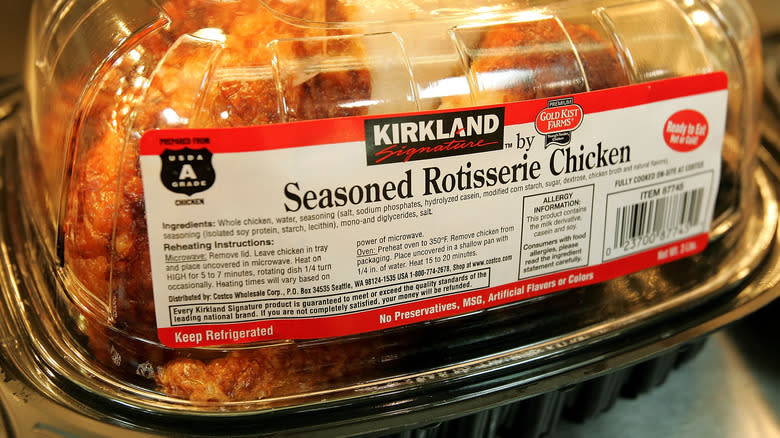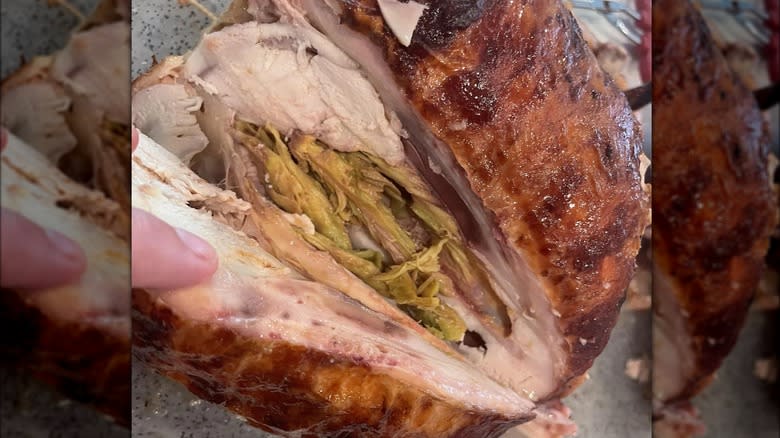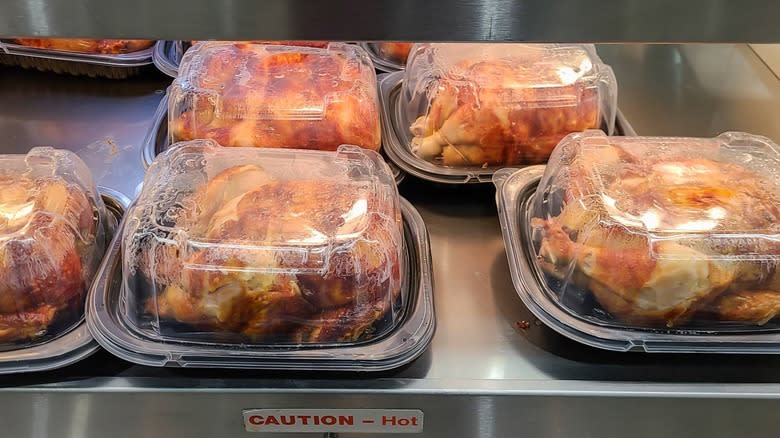What It Means If Your Costco Rotisserie Chicken Is Green

Along with the store's innumerable bulk products, Costco is also well-known for its tasty rotisserie chicken. However, one member of the warehouse retail chain made a troubling discovery after a recent purchase and headed to Reddit to get some more insight. Upon digging into the chicken, the shopper found that a portion of the meat was an unappealing green color. The accompanying photo was so off-putting that it was concealed under a spoiler tag to prevent squeamish Redditors from inadvertently laying eyes on it. Lots of commenters pointed out that it looked like a case of green muscle disease, and it's not unique to Costco chicken.
According to the United States Department of Agriculture (USDA), ischemic myopathy (green muscle disease's formal name) results from disruptions in the blood supply to the bird's pectoral -- or breast -- muscles. Commercially reared poultry tend to have far larger breast muscles than they would normally, which means that the blood supply to the muscles is inadequate. Because the blood supply is already insufficient, the flow of blood can be completely cut off if the bird flaps its wings vigorously. In addition to turning green, the muscle tissue also becomes tough and stringy.
Read more: The 12 Best Grocery Store Rotisserie Chickens, Ranked
Can You Eat A Chicken With Green Muscle Disease?

Per the USDA, green muscle disease does not "present a food safety hazard to the consumers." Because the issue does not result from infection by a pathogen, chickens with green muscle disease are considered safe to eat. Still, while green chicken is not likely to cause foodborne illness, it's far from appetizing. Despite the lack of safety issues associated with ischemic myopathy, consumers are very put off by the defect. As succinctly stated by a Costco shopper on Reddit, "Oh my, I gagged. Not normal."
This poses an issue to chicken processors, who experience losses when poultry with green muscle disease must be discarded. And while poultry manufacturers are urged to limit activity among birds to prevent blood flow from being disrupted, the real issue stems from industry practices focused on generating larger and larger breast muscles in chickens. This is also why store-bought chicken often has a tough, chewy texture -- a phenomenon known as woody breast.
What To Do About Green Meat (And Are Costco Chickens Still Worth Buying)?

In the Reddit thread discussing the presence of green meat in Costco chicken, many commenters encouraged the original poster to return the chicken for a refund. Members should be mindful of abusing this policy, however, as too many returns may result in a canceled Costco membership. Some recommended that the person return the remainder of the offending chicken, while others claimed that it wasn't necessary. A few people suggested snapping a picture of the bird to make the store aware of the issue. According to the Costco website, customers are encouraged to bring the receipt and packaging when in search of a refund, but these items "may not be necessary to process your return."
Costco rotisserie chickens are what's known as a loss leader, which means that the store loses money on the product by selling it for less than the cost it takes to provide the chicken to customers. However, loss leaders are beneficial in the sense that they draw in consumers, which gives them ample opportunity to make other purchases. The low cost of Costco chicken can also mean low quality, as the rotisserie birds have underperformed when compared to chickens from Whole Foods and Safeway. As a commenter on Reddit put it, "$5 chicken, $5 result."
Read the original article on Daily Meal

